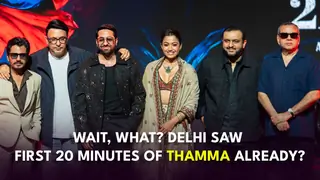Posted:
While society has slowly accepted the 'other woman', Bollywood continues to go by the stereotype. We question the schism...
Who says real life inspires reel life? If that's so, why is the 'other woman' in our films either a scheming vamp or a goody-goody sacrificing woman who lets go of the man she loves?
This when real life cases point otherwise. To bring in some recent examples - Aamir Khan's second marriage with Kiran Rao and Saif planning to take the same route with Rosa.
And recently, there are rumours that filmmaker Vikram Bhatt has based the role of Kavya in his film Ankahee on his own relationship with Sushmita Sen, which led to his divorce.
He says,"Sometimes, a relationship is circumstantially driven, but it is a reality. And no, Ankahee is not based on any particular person, but on a phase of my life when I was emotionally vulnerable."
In the film, Esha portrays a self-obsessed beauty queen who wrecks havoc in her lover's life, finally leading to the break-up of his marriage.
So, what is the lure of the other woman and why cannot she outlive the Bollywood stereotype?"It's the forbidden-fruit syndrome.
The unattainability factor,"explains filmmaker Mahesh Bhatt."Outside cinema, the other woman can be called the collective aspiration of a generation. She is a part of every man's yearning, and that is why she refuses to die."
But in Bollywood, though the man chases his 'other', he never walks into the sunset with her. For instance, Waheeda Rehman's Shanti in Kagaz ke Phool in 1959 or Parveen Babi in Yeh Nazdikiyaan.
As Bhatt says,"Status quo must be restored in the movies, because at the end of it all, cinema is make-believe, and we cannot have an opposition of the happily-ever-after there."
Movies like the path-breaking Arth, where the woman walks out both on her husband and lover, and Souten, which managed to weave in caste divides into this classic story, were followed by a spate of movies that set this theme to comedies - and a Sajan Chale Sasural or a No Entry was made.
So, has our society become 'other woman' friendly enough to laugh about the situation? Alyque Padamsee, adguru, says,"She was always deeply embedded in the Indian sociological mindset.
Nobody bothers if they have two wives, affairs, second marriages."Then why the schism in the movies? Replies Alyque,"This because the scriptwriters are looking through the rear-view mirror into the past for inspiration."
Who says real life inspires reel life? If that's so, why is the 'other woman' in our films either a scheming vamp or a goody-goody sacrificing woman who lets go of the man she loves?
This when real life cases point otherwise. To bring in some recent examples - Aamir Khan's second marriage with Kiran Rao and Saif planning to take the same route with Rosa.
And recently, there are rumours that filmmaker Vikram Bhatt has based the role of Kavya in his film Ankahee on his own relationship with Sushmita Sen, which led to his divorce.
He says,"Sometimes, a relationship is circumstantially driven, but it is a reality. And no, Ankahee is not based on any particular person, but on a phase of my life when I was emotionally vulnerable."
In the film, Esha portrays a self-obsessed beauty queen who wrecks havoc in her lover's life, finally leading to the break-up of his marriage.
So, what is the lure of the other woman and why cannot she outlive the Bollywood stereotype?"It's the forbidden-fruit syndrome.
The unattainability factor,"explains filmmaker Mahesh Bhatt."Outside cinema, the other woman can be called the collective aspiration of a generation. She is a part of every man's yearning, and that is why she refuses to die."
But in Bollywood, though the man chases his 'other', he never walks into the sunset with her. For instance, Waheeda Rehman's Shanti in Kagaz ke Phool in 1959 or Parveen Babi in Yeh Nazdikiyaan.
As Bhatt says,"Status quo must be restored in the movies, because at the end of it all, cinema is make-believe, and we cannot have an opposition of the happily-ever-after there."
Movies like the path-breaking Arth, where the woman walks out both on her husband and lover, and Souten, which managed to weave in caste divides into this classic story, were followed by a spate of movies that set this theme to comedies - and a Sajan Chale Sasural or a No Entry was made.
So, has our society become 'other woman' friendly enough to laugh about the situation? Alyque Padamsee, adguru, says,"She was always deeply embedded in the Indian sociological mindset.
Nobody bothers if they have two wives, affairs, second marriages."Then why the schism in the movies? Replies Alyque,"This because the scriptwriters are looking through the rear-view mirror into the past for inspiration."


















